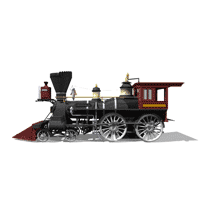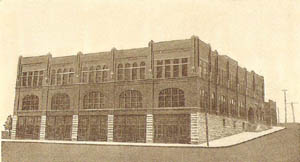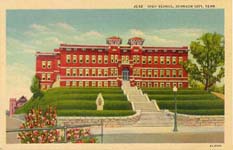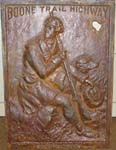Questions
from visitors to Johnson's Depot.......
If you
did not find the answer to your question, from time to time Henry will
check his e-mail and may choose to add questions to this page. To forward
a comment or question to Henry or an Associate, e-mail your questions
to henry@johnsonsdepot.com.
Back to the Johnson's Depot Homepage
Was Henry Johnson really the unanimous choice for Mayor
of Johnson City? Wallace T. - Longview,
TX
Yes. Henry received all
60 votes (from the registered male voters) in the election of January
3, 1870. You can view the official election tally here.
Back to top
Where was the original
Carnegie Hotel? Mary
G.- Johnson City, TN
 |
|
Updated
Report
|
The
original Carnegie Hotel stood on the site of the former Empire Furniture Company
at 1200 East Fairview Avenue. This property now is part of the American Water Heater manufacturing complex (division of A.O. Smith Company. Research at the Archives of Appalachia
and the discovery of an obscure photograph
(See Enhanced Version)from the Burr
Harrison Collection plainly reveals that contrary to what was previously
reported here, the ruins of the Carnegie Hotel were not incorporated
into the Empire Furniture Company Building(s) on Fairview. In the photo,
the Carnegie Hotel is the building shown
on the right. See 1917 ad for Empire Chair Company. See 1928 photo
of Empire Furniture. See 1930 photo
of Empire Furniture. See 1950 aerial
photo of Empire Furniture.
The
building shown in the photos below is the South and Western Railway office
building (later Clinchfield Railroad) which looked very similar to the
Carnegie Hotel and was across the street from the Carnegie. This
map shows the locations of the buildings (only Broadway of the streets
shown still exists today). The Carnegie Hotel did burn to the ground in
1910 and nothing was salvaged. Read
news account of the fire. The accounts shown below stands corrected
based upon the collaboration of the Archives of Appalachia staff.
Note:
The following statements have been proven incorrect. The ruins
of the original Carnegie Hotel, built in 1891 by Civil War General John
Wilder, still exist and are discernable today. The hotel was
not rebuilt after a fire in April 1910 and the shell of the hotel
building (possibly half of the original structure) was salvaged and used
(until 2004) as warehouse space for the Empire Furniture Company located
at 1200 East Fairview Avenue in Johnson City. Ray Stahl's book
Greater Johnson City: A Pictorial History (published in 1986)
also concluded that "The Hotel Carnegie burned around 1909-09 and
was not rebuilt. The Empire Furniture Company now uses the shell of the
building for a warehouse."
Update:
the
old warehouse structure used by Empire Furniture Company has now been
identified as the South and Western Railway Building and not the Carnegie
Hotel. The resemblance and design of the buildings is striking and the
longstanding debate over whether or not part of the old Carnegie Hotel
had been salvaged after the devastating fire of 1910 is now resolved. Remaining portions of the South and Western Railway Building were demolished in 2008.
The
hotel cost from $125,000 to $150,000 to build and was a luxurious facility
for its time. The present
Carnegie
Hotel built in 2001 across from East Tennessee State University was
inspired by the original "railroad baron's hotel" from the 1890s
when Johnson City and the Carnegie section were "boom towns"
spurred by speculation from railroad and mining interests. Read the
Johnson City Comet 1891 news article on the construction
of the Hotel Carnegie.
Comparison of South and Western RR Building
(Later Empire Furniture Warehouse)
with Carnegie Hotel (Both built by General John T. Wilder)
|
|
|
|
|
 |
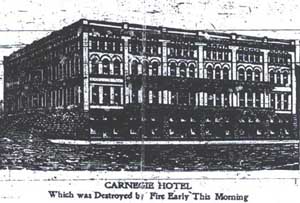 |
Empire Furniture Company Property:
2005 |
Carnegie Hotel - News
Account of Fire |
Note: The Empire Chair/Furniture Building above originally was the South
and Western Railway office building located adjacent to the original
Carnegie Hotel (destroyed by fire in 1910).
| Photos
of former South and Western Office Building: |
| |
|
|
|
|
|
|
|
Note: Remaining portions of this building were demolished in 2008. |
Back
to top
Was Johnson City
almost renamed "Carnegie" for Andrew Carnegie?
Orville R.- Racine, WI
There
are several historical accounts that support this claim. In a study of
"Carnegie Libraries in Tennessee, 1889-1919" it is reported
that industrialist Andrew Carnegie (1835 - 1919) funded the construction
of at least nineteen libraries and several educational buildings in Tennessee
between 1900 and 1919, including one at the National Soldiers Home in
Johnson City. "One library that did not get built would have
been a $100,000 facility in Johnson City. The citizens refused the offer
in 1889 because it would have required them to rename their town
after Carnegie." Another account states that Carnegie
offered to build a large steel mill if Johnson City changed its name
to "Carnegie." Both these accounts could have some validity
based upon Carnegie's other ventures during the same
time period. "The second Carnegie Library was given to Braddock,
Pennsylvania in 1889, which housed one of Carnegie Steel Company's major
steel mills, the Edgar Thomson Works. Since this library primarily served
the employees of the Carnegie Steel Company, and their families, the company
funded the library." The Johnson City Comet news articles
from 1889 are reprinted here.
These
items need to be researched in much more detail. It is curious that Civil
War General John Wilder named so many of his railway properties
in eastern Johnson City after Andrew Carnegie in the late 1880s and early
1890s and the exact association between Wilder and Carnegie, if any, is
not clear. General Wilder was quite an enthusiastic promoter and
some historians have thought he might have been only trying to use Carnegie's
name to stimulate interest from additional investors from throughout the
nation. Union Civil War General Clinton B. Fisk (benefactor and namesake
of Fisk University in Nashville) was another northern capitalist and railroad
developer said to be an investor in mineral extraction interests around
Johnson City during the boom years of the late 1880s. Andrew Carnegie
was the richest
man in the world and basically controlled the U.S. steel industry
during the late nineteenth century. It would be consistent with the aggressive
nature of Carnegie's steel industry acquisitions of the period, that Johnson
City's boom era of mining, railway, and iron/steel activity attracted
his attention and some level of interest was there, even to the degree
of being a partner, possibly through another name or company. John Wilder's
previous success in developing Chattanooga's industries and his international
fame as an expert in manufacturing (he hosted a visit to Johnson City
by the British Duke of Marlborough to view the Cranberry Mines, for example)
placed Wilder in the circles to easily have association with Andrew Carnegie.
The concept of Johnson City as a major center for steel and iron production
became moot after the
financial panic of 1893 when John Wilder lost his
fortune and many railway and related companies failed nationally. A close
parallel to the railway collapse of the 1890s was the "dot-com"
financial collapse a century later. Read a
biography of General John T. Wilder.
|
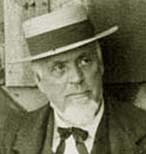 |
500
Passage Ticket for Johnson City and Carnegie Street Railway |
John T. Wilder in 1886 |
| |
|
|
Back to top
Did two brothers from Johnson City compete against each other for
Governor of Tennessee?
Louise S. - Mount Airy, North Carolina
Yes.
In the 1886 election for Tennessee's Governor, the Taylor brothers,
Robert (Bob) and
Alfred (Alf), ran against each other prompting the "War
of The Roses" campaign that gained national attention. Democratic
supporters of Robert L. Taylor wore white roses and Republicans supporting
Alfred sported red roses. Farmers' support for Robert Taylor helped win
him the election. Alf later was elected Governor of Tennessee in 1920.
The Taylors were natives of Carter County but both owned and lived in
the home at 1309 South Roan Street in Johnson
City (at different times) nicknamed "Robins'
Roost". Bob Taylor was one of the original founders of the Johnson
City Comet newspaper, an attorney, and a United States Senator, and
possibly the most charismatic politician in Tennessee
history.
Back to top
Who was the toughest
man to reside in Johnson City?
Mike S. - Wichita Falls, TX
Interesting
question Mike. This is a little too subjective for either Henry or the
Associates to tackle but we shall offer these comments: Henry reports
that in his opinion Johnson City took a backseat to Jonesborough in this
regard. Andrew Jackson as a young attorney and judge
in Jonesborough was absolutely fearless and it was not uncommon for
law offenders to turn themselves in rather than have Jackson come looking
for them - with or without deputies or a posse.
Jackson also challenged the noted attorney
Waightstill Avery to a duel in Jonesborough
but the issue was resolved satisfactorily without bloodshed.
Legend places
Alphonse Capone in Johnson City as an occasional (?)
guest of the John Sevier Hotel and the Montrose
Court Apartments, so in the 20th Century some support might be given
to Capone. Al Capone used Johnson City as a mid-point stopover between
Chicago and Miami, but of course Capone's travel itinerary is basically
undocumented. The Appalachian Mountain region and its native moonshine
industry were key elements in the supply chain of illegal alcohol during
the Prohibition years with Johnson City being a natural geographic and
transportation hub for these activities. Daily reports from The Johnson City Staff-News, vividly recount Johnson City during the Roaring 1920s with quite amazing stories of jailbreaks, bootlegging raids, allegations against the police department/local officials and essentially a small city's struggle to deal with the pressures of Prohibition similar to Chicago (without the gangland murders). Stories related to a mysterious
series of tunnels originating from Montrose Court and various other Prohibition-era
establishments in Johnson City are a consistent part of the "Little
Chicago" local folklore. The years Capone was present in
Johnson City were likely 1924 - 1928 according to research by local historians.
On one documented visit to the Atlanta Penitentiary to visit Al, Capone's
beautiful wife Mae was accompanied by a lady from Johnson City. Biographies and research related to Al Capone have focused on gangster activities around Chicago and the drama associated with his eventual imprisonment for income tax evasion. Research into his alcohol distribution network and deal-making with moonshiners and suppliers from Canada to the Appalachian Mountains has never been undertaken.
Back to top
When was President Benjamin Harrison's visit
to Johnson City: 1890 or 1891?
Sharon F. - Telford, TN
Sharon, great question. A Johnson City
Comet issue dated April 14, 1890 features President Harrison's
visit. However, Ray Stahl's
History of Johnson City publication indicates that 1891 was the
date of the President's railway trip to the west coast and that the
Comet had a printing error that incorrectly showed the year in its
report. After researching this further it does appear that Mr. Stahl is
absolutely correct as subsequent issues of the Comet in April 1891 chronicle the President's trip to the west coast with almost daily articles. In Johnson City a crowd of over 5,000 turned out to see the President which was an incredible feat for a town with a total population of slightly over 4,000 people. Here are the Comet articles on the President's visit as well as a transcription of his speech.
Although Rutherford B. Hayes was the first President to travel to the
west coast and back by train, Benjamin Harrison made the first "whistle-stop"
tour with speeches at key locations and what is touted as the first trans-continental
tour by a President. President Hayes used the railroads primarily on his
westward tour (he went overland at some key locations) while Harrison
used exclusively the railroads for his trip and combined the speaking
tour that would be made famous by later Presidents such as Theodore Roosevelt.
Back
to top
Was Johnson City the first city chosen for the
National Soldiers Home
in Tennessee? Janie F. - Albany, NY
No. Congressman
Walter P. Brownlow (who obtained the massive amount of federal funding
necessary for the project) originally considered Greeneville, Tennessee,
the largest city in the 1st Congressional District at that time, as the
site of the Home (present day Veterans Affairs Center in Johnson City).
Greeneville was given a choice of either the Soldiers Home or the
U.S. Court House for their city. Following Greeneville's decision
in favor of the Court House, Johnson City became the site of the Soldiers
Home. Speculation has occurred on this subject that Greeneville citizens
may have been concerned of bringing in large numbers of very ill persons
to the community given the crude state of health care and lack of antibiotics
around 1900. It is also speculated that the scale of the project that
Brownlow intended to build (an entire medical campus) was possibly not
clear. The National Soldiers Home was an unprecedented federal project
for its time (particularly to be placed in a southern state following
the Civil War) and led Johnson City's economic resurgence following the
railroad financial collapse of the 1890s.
Back to top
Why were there three
passenger depots in Johnson City instead of a larger one serving all
three railway systems?
Mark G. - Pierre, South Dakota
Prior to the 1893 financial crash that stopped John Wilder's 3-Cs Railway
project (forerunner to the Clinchfield), Wilder had started construction
on a massive "union" depot that could have served several railway
lines. Wilder's union depot would have been located near the original
Carnegie Hotel in East Johnson City. Both the Southern Railway and ET&WNC
shared a depot from 1892
until 1912 (present Free Service Tire facility). The shared depot was
referred to as a "union depot" as evidenced by this saloon
advertisement but in actuality was not of the scale envisioned by
a depot typically classified as a "union" depot.
Several histories recount that George L. Carter, President of the Clinchfield
Railway, refused to participate in a joint venture with Southern Railway
resulting in Southern building their own depot
in 1912. There was a considerable rivalry between the Southern and
Clinchfield for freight business for a period of time (often quite violent)
and George Carter was said to be leery of direct partnering with his larger
competitor. The Clinchfield Railway created a massive shortcut across
the Blue Ridge Mountain range that dramatically affected freight distances
and pricing and was the last new Class 1 railroad built east of the Mississippi
River in the United States. Johnson City's civic leaders strongly supported
a union depot and development of more significant railway structures but
this element was never achieved, leaving the 3 smaller depots (all within
easy walking distance of each other) as the final result.
Back to top
Where did General
John Wilder reside in Johnson City? Jefferson P. - Chickamauga,
GA
General
John T. Wilder lived at the corner of Spring and West Maple Streets in
Johnson City (located across from First Methodist Church)and his home
has been beautifully restored. Supposedly the annex building behind the
main home served as a "warroom" for the planning of major railway
lines and other projects in the late 1800s. Here are a few photos of the
home:
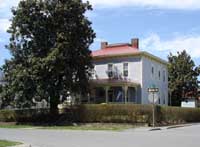 |
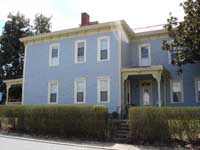 |
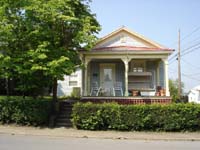 |
Front
View |
Spring
Street Side |
Annex
(Warroom) |
John
Wilder owned a second house almost identical to his Johnson City home
in Roan Mountain, Tennessee which operated for several years as General Wilder's Bed and
Breakfast." Wilder also built the original Cloudland
Hotel in Roan Mountain and recognized the scenic beauty and tourism
potential of Northeast Tennessee and Western North Carolina which were
to be served by his railroads. View an 1890s photo
of the Cloudland Hotel. Below are a few views of Wilder's home in
Roan Mountain:
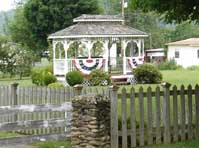 |
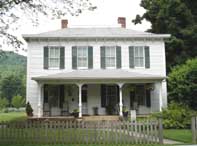 |
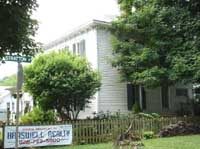 |
Gazebo |
General
Wilder's Roan Mountain Home(Front) |
Stratton
Street Side |
How many children
did Henry Johnson have and what were their names? Shirley B.
- Johnson City
The
1850 Census of Tennessee lists the Henry Johnson household as follows:
Henry
Johnson 41 years of age, his wife Mary was 39, children: Sarah
age 15, Edward 13, John 11. Both Edward
and John fought for the Union Army in the Civil War and accompanied noted Federal scout and pilot
Captain Daniel Ellis on a February 1864 trip to join forces in Knoxville.
Johnson family histories record another daughter who died in infancy,
and a son named William H. H. (Harrison) who died during the Civil
War. Harrison Johnson is buried in Oak Hill Cemetery in Johnson City.
Link to 1860 Census for Washington County - Brush Creek District
Have the Johnson
Associates discovered any previously unknown facts about Henry?
James R. - Raleigh, North Carolina
Yes
James, a surprising revelation was recently discovered in an Archives
of Appalachia collection that was documented by the famed historian Samuel
Cole Williams. Judge Williams in 1941, wrote a news article with the fact
that Henry Johnson, in addition to being a merchant and a farmer, was
also an inventor. In 1835 Henry registered a patent with the
U.S. Patent Office for a threshing machine which separated the seeds of
wheat plants from the husks and stems; the wheat seeds becoming grain,
the stems straw. Read the article here.
Another interesting discovery at the Archives are items in the Lester Moore Collection. Lester Moore was a great-grandson of Henry Johnson and his grandmother was Henry's daughter Sarah. A number of family items and important Johnson genealogy can be found here. A note placed in a Seth Thomas clock owned by Henry Johnson (clock is shown below) indicates that Henry Johnson and future President Andrew Johnson migrated to Tennessee together from North Carolina. Family legends indicate the Johnsons were cousins but this has not been verified due to sketchy information on ancestors of both men. Their lifespans were amazingly similar. Henry was born in 1809 and died on February 25, 1874. Andrew Johnson was born December 28, 1808 and died on July 31, 1875.
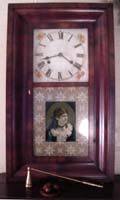
Seth Thomas clock owned by Founder Henry Johnson
A tag inside the clock indicates a repair in 1825
Whatever happened to the Daniel Boone Trail marker that was formerly located at the old Science Hill High School? Larry L. - Newport News, Virginia, Science Hill Class of 1956
Larry, a Johnson City Press article detailed this longstanding mystery. The story as recently told to the Johnson Associates is that in April 1979, while the old high school was in the process of demolition two civic-minded gentlemen, who have elected to remain anonymous, saw the old monument (an arrowhead - shaped section of concrete with a bronze marker bolted in) lying on the ground and after passing by again later in the day saw the partially crushed monument being loaded onto a dump truck, presumably destined for the city landfill. One of the men asked if he could have the historic marker (bronze plaque)- and the construction crew said that was fine with them. The two gentlemen unbolted the marker from the concrete monument which would have been virtually impossible to move and salvage due to its weight. Since April 1979, the historic marker has been safely in storage wrapped in a soft protective fleece-lined sleeve. Here is a photo of Johnson City's historic Daniel Boone marker. It is thought that the hole in the marker was due to leeching from the limestone based concrete. The marker is in excellent condition otherwise. As noted in the news article, the metal used in the casting for the marker was from the Battleship - U.S.S. Maine.
The Daniel Boone marker along with the Lady of the Fountain statue, and numerous historic railway artifacts have been preserved only due to the actions of heroic individuals who felt these items would one day have great significance to Johnson City's heritage and should not be destroyed. Note: The Daniel Boone marker was reconstructed and rededicated on June 6, 2006 in close proximity to its original location.
|
|
Note the Arrow-Shaped Marker in center-left of postcard above |
Daniel Boone Trail Marker:
Alive and Well |
Back
to top
of
a
|
